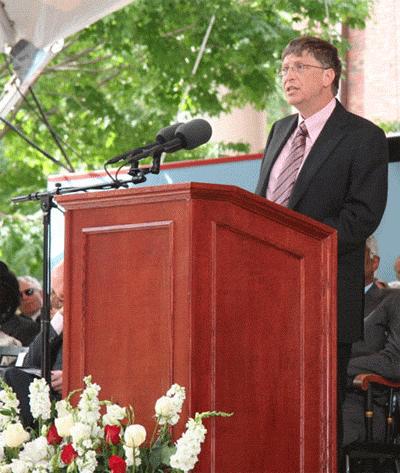比尔·盖茨:永远别向复杂低头
2008-01-08 21:18
337 查看
改变世界的阻碍,并非人类的冷漠,而是世界的太过复杂性。
为了将关心转变为行动,我们需要找到问题,发现解决方法,评估后果。但是复杂性阻碍了这些步骤。
就算我们真地发现了问题所在,也不过是迈出了第一步,接着还有第二步:那就是从复杂的事件中找到解决办法。
从复杂中找到解决办法可以分为四个步骤:确定目标,找到最高效的方法,发现适用于这个方法的新技术,同时最聪明地利用现有的技术——不管它是复杂的药物,还是最简单的蚊帐。
在发现问题、找到解决方法之后,就是最后一步——评估工作结果,将你的成功经验或者失败教训分享,这样其他人就可以从你的努力中有所收获。
但是如果你想激励其他人参加你的项目,你就必须拿出比统计数字更多的东西:你必须展示你工作的人性因素,这样人们才会感到拯救一个生命对那些处在困境中的家庭意味着什么。

对应原句:
The barrier to change is not too little caring; it is too much complexity.
To turn caring into action, we need to see a problem, see a solution, and see the impact. But complexity blocks all three steps.
If we can really see a problem, which is the first step, we come to the second step: cutting through the complexity to find a solution.
Cutting through complexity to find a solution runs through four predictable stages: determine a goal, find the highest-leverage approach, discover the ideal technology for that approach, and in the meantime, make the smartest application of the technology that you already have — whether it's something sophisticated, like a drug, or something simpler, like a bednet.
The final step – after seeing the problem and finding an approach – is to measure the impact of your work and share your successes and failures so that others learn from your efforts.
But if you want to inspire people to participate, you have to show more than numbers; you have to convey the human impact of the work – so people can feel what saving a life means to the families affected.
为了将关心转变为行动,我们需要找到问题,发现解决方法,评估后果。但是复杂性阻碍了这些步骤。
就算我们真地发现了问题所在,也不过是迈出了第一步,接着还有第二步:那就是从复杂的事件中找到解决办法。
从复杂中找到解决办法可以分为四个步骤:确定目标,找到最高效的方法,发现适用于这个方法的新技术,同时最聪明地利用现有的技术——不管它是复杂的药物,还是最简单的蚊帐。
在发现问题、找到解决方法之后,就是最后一步——评估工作结果,将你的成功经验或者失败教训分享,这样其他人就可以从你的努力中有所收获。
但是如果你想激励其他人参加你的项目,你就必须拿出比统计数字更多的东西:你必须展示你工作的人性因素,这样人们才会感到拯救一个生命对那些处在困境中的家庭意味着什么。

对应原句:
The barrier to change is not too little caring; it is too much complexity.
To turn caring into action, we need to see a problem, see a solution, and see the impact. But complexity blocks all three steps.
If we can really see a problem, which is the first step, we come to the second step: cutting through the complexity to find a solution.
Cutting through complexity to find a solution runs through four predictable stages: determine a goal, find the highest-leverage approach, discover the ideal technology for that approach, and in the meantime, make the smartest application of the technology that you already have — whether it's something sophisticated, like a drug, or something simpler, like a bednet.
The final step – after seeing the problem and finding an approach – is to measure the impact of your work and share your successes and failures so that others learn from your efforts.
But if you want to inspire people to participate, you have to show more than numbers; you have to convey the human impact of the work – so people can feel what saving a life means to the families affected.
相关文章推荐
- 比尔·盖茨:永远别向复杂低头
- 比尔·盖茨:永远别向复杂低头
- 比尔·盖茨:永远别向复杂低头
- 比尔·盖茨:永远别向复杂低头
- 比尔·盖茨:永远别向复杂低头
- 比尔·盖茨
- 为什么比尔·盖茨可以有大成就?
- 比尔·盖茨:21世纪的新型资本主义
- [转]比尔·盖茨在哈佛大学毕业典礼上的演讲
- 微软二十五年(比尔·盖茨) --- 一步一步思考,一步一步创建
- 比尔·盖茨想啥呢,在?
- 比尔·盖茨(Bill Gates)
- 比尔·盖茨:统一通讯技术就是未来趋势
- 比尔·盖茨2007年6月7日在哈佛大学毕业典礼上的演讲
- Windows 8不达预期 比尔·盖茨应出山拯救微软
- 比尔·盖茨持有过的中国股票
- 比尔·盖茨的人际关系法则
- 比尔·盖茨给毕业生的忠告
- 改变这个世界深刻的不平等--比尔·盖茨
- 【转载】比尔·盖茨是如何花钱的
